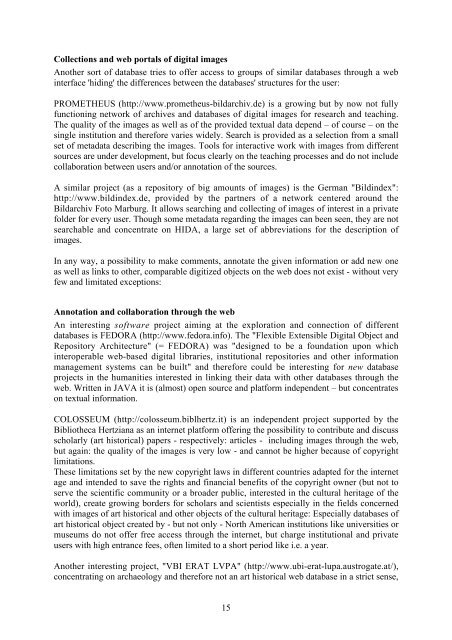European Cultural Heritage Online - ECHO
European Cultural Heritage Online - ECHO
European Cultural Heritage Online - ECHO
Create successful ePaper yourself
Turn your PDF publications into a flip-book with our unique Google optimized e-Paper software.
Collections and web portals of digital imagesAnother sort of database tries to offer access to groups of similar databases through a webinterface 'hiding' the differences between the databases' structures for the user:PROMETHEUS (http://www.prometheus-bildarchiv.de) is a growing but by now not fullyfunctioning network of archives and databases of digital images for research and teaching.The quality of the images as well as of the provided textual data depend – of course – on thesingle institution and therefore varies widely. Search is provided as a selection from a smallset of metadata describing the images. Tools for interactive work with images from differentsources are under development, but focus clearly on the teaching processes and do not includecollaboration between users and/or annotation of the sources.A similar project (as a repository of big amounts of images) is the German "Bildindex":http://www.bildindex.de, provided by the partners of a network centered around theBildarchiv Foto Marburg. It allows searching and collecting of images of interest in a privatefolder for every user. Though some metadata regarding the images can been seen, they are notsearchable and concentrate on HIDA, a large set of abbreviations for the description ofimages.In any way, a possibility to make comments, annotate the given information or add new oneas well as links to other, comparable digitized objects on the web does not exist - without veryfew and limitated exceptions:Annotation and collaboration through the webAn interesting software project aiming at the exploration and connection of differentdatabases is FEDORA (http://www.fedora.info). The "Flexible Extensible Digital Object andRepository Architecture" (= FEDORA) was "designed to be a foundation upon whichinteroperable web-based digital libraries, institutional repositories and other informationmanagement systems can be built" and therefore could be interesting for new databaseprojects in the humanities interested in linking their data with other databases through theweb. Written in JAVA it is (almost) open source and platform independent – but concentrateson textual information.COLOSSEUM (http://colosseum.biblhertz.it) is an independent project supported by theBibliotheca Hertziana as an internet platform offering the possibility to contribute and discussscholarly (art historical) papers - respectively: articles - including images through the web,but again: the quality of the images is very low - and cannot be higher because of copyrightlimitations.These limitations set by the new copyright laws in different countries adapted for the internetage and intended to save the rights and financial benefits of the copyright owner (but not toserve the scientific community or a broader public, interested in the cultural heritage of theworld), create growing borders for scholars and scientists especially in the fields concernedwith images of art historical and other objects of the cultural heritage: Especially databases ofart historical object created by - but not only - North American institutions like universities ormuseums do not offer free access through the internet, but charge institutional and privateusers with high entrance fees, often limited to a short period like i.e. a year.Another interesting project, "VBI ERAT LVPA" (http://www.ubi-erat-lupa.austrogate.at/),concentrating on archaeology and therefore not an art historical web database in a strict sense,15


